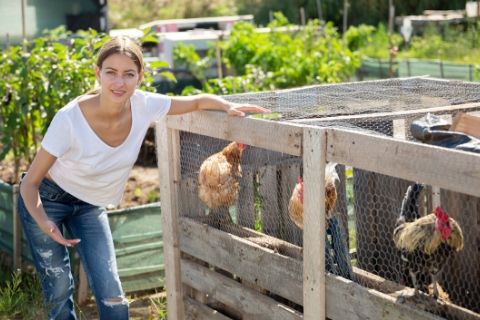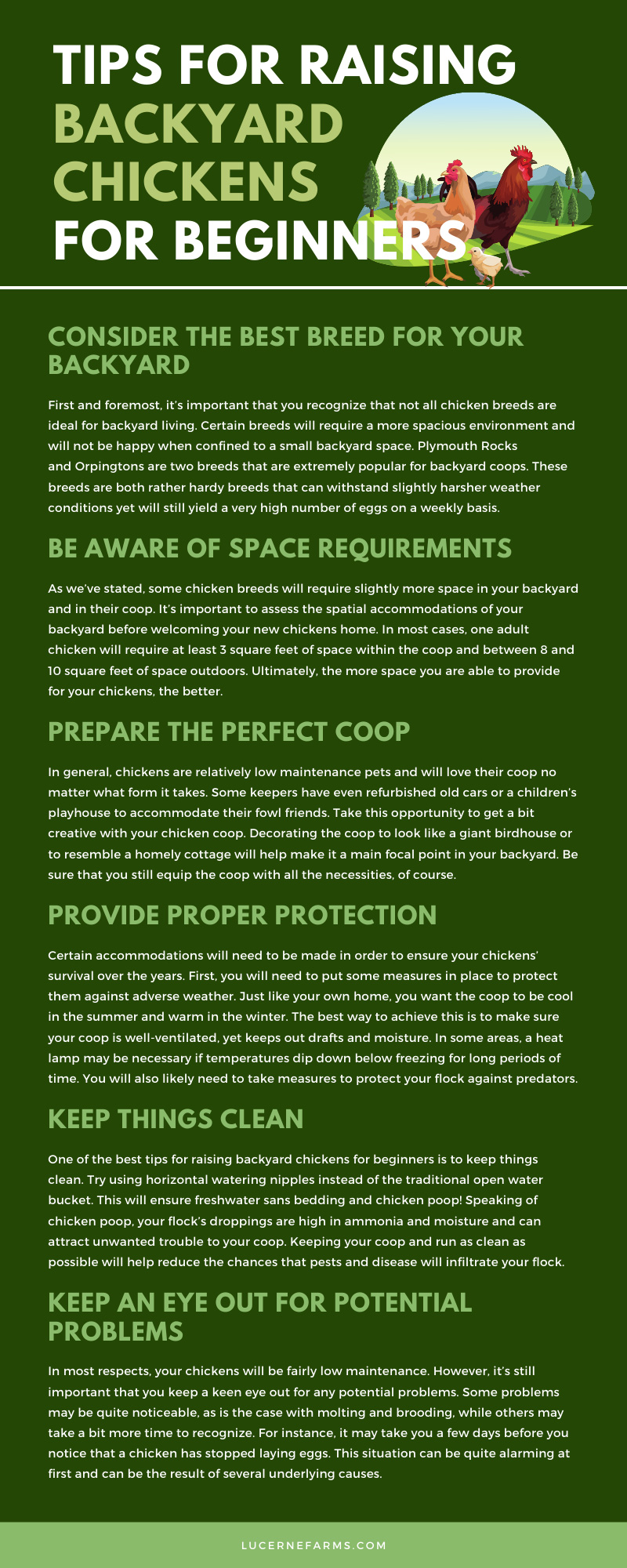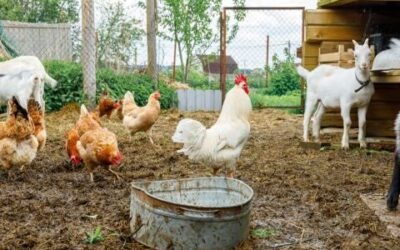
Raising backyard chickens can be a very rewarding experience for many different reasons. Not only will it allow you to easily procure your own organic eggs, but it can be a rather therapeutic experience. Like all animals, chickens can develop their own personalities that will make the entire experience more fun and worthwhile. For first-time chicken owners, however, the experience may be a bit daunting at first glance. While the initial planning period can be a bit nerve-wracking, you can rest assured that it will all pay off in the long run. This guide provides several helpful tips for raising backyard chickens for beginners that will help you kickstart this new experience with as little stress as possible.
Consider the best breed for your backyard
First and foremost, it’s important that you recognize that not all chicken breeds are ideal for backyard living. Certain breeds will require a more spacious environment and will not be happy when confined to a small backyard space. Plymouth Rocks and Orpingtons are two breeds that are extremely popular for backyard coops. These breeds are both rather hardy breeds that can withstand slightly harsher weather conditions yet will still yield a very high number of eggs on a weekly basis. Both are popular among first-timers due to their relaxed and responsive nature. Additionally, they tend to be very friendly toward children and are therefore a great addition to the family.
Be aware of space requirements
As we’ve stated, some chicken breeds will require slightly more space in your backyard and in their coop. It’s important to assess the spatial accommodations of your backyard before welcoming your new chickens home. In most cases, one adult chicken will require at least 3 square feet of space within the coop and between 8 and 10 square feet of space outdoors. Ultimately, the more space you are able to provide for your chickens, the better. This helps reduce overcrowding, feather pecking, fighting, and the spread of disease. When considering the spatial requirements for your chickens, it’s also important to consider your city’s specific ordinances regarding backyard chickens. Some cities may be stricter about the acceptable size of a backyard coop or the number of chickens you’re allowed to keep on your property at once. Familiarizing yourself with these ordinances will not only keep you on the right side of the law, but will also help give your chickens the healthiest and happiest life possible.
Prepare the perfect coop
In general, chickens are relatively low maintenance pets and will love their coop no matter what form it takes. Some keepers have even refurbished old cars or a children’s playhouse to accommodate their fowl friends. Take this opportunity to get a bit creative with your chicken coop. Decorating the coop to look like a giant birdhouse or to resemble a homely cottage will help make it a main focal point in your backyard. Be sure that you still equip the coop with all the necessities, of course. A standard chicken coop should include nesting boxes, proper ventilation, and some form of a roost. You will need one nesting box for every three chickens, though it can be beneficial to have a few extra. This will help reduce the amount of fighting as your chickens vie to stake their claim on the best nesting box. Your coop and outdoor area, their run, should also allow sufficient space for the chickens to feed. Chickens prefer to eat continuously throughout the day and enjoy scratch feeding, which requires a significant amount of space. Be sure to factor this into your calculations when crafting the coop.
Provide proper protection
Certain accommodations will need to be made in order to ensure your chickens’ survival over the years. First, you will need to put some measures in place to protect them against adverse weather. Just like your own home, you want the coop to be cool in the summer and warm in the winter. The best way to achieve this is to make sure your coop is well-ventilated, yet keeps out drafts and moisture. In some areas, a heat lamp may be necessary if temperatures dip down below freezing for long periods of time. You will also likely need to take measures to protect your flock against predators. Foxes, hawks, wild dogs, and even rodents will see your chickens as a tasty midnight snack and will do everything in their power to get to them. Use chicken wire to create a stable barrier around the coop and run. Make sure the run is also covered with chicken wire. Block predators’ efforts to dig their way in by burying chicken wire at least a foot deep around the outside of the coop and run. Because many unwanted visitors can sneak through standard chicken wire, it’s a good idea to use ¼” to ½” wire mesh on all windows and vents of your coop.
Keep things clean
One of the best tips for raising backyard chickens for beginners is to keep things clean. Try using horizontal watering nipples instead of the traditional open water bucket. This will ensure freshwater sans bedding and chicken poop! Speaking of chicken poop, your flock’s droppings are high in ammonia and moisture and can attract unwanted trouble to your coop. Keeping your coop and run as clean as possible will help reduce the chances that pests and disease will infiltrate your flock. The kind of bedding you use can help. As we mentioned, ammonia and moisture can be a big problem for not only your nose, but for your chickens’ health as well. Steering clear of shavings and using a hay/straw blend like Koop Clean for your chicken bedding will not only provide them with mental stimulation as they till through the straw and grass heads, but the dehydrated nature of the bedding, combined with Sweet PDZ, will also lower moisture and reduce ammonia build-up. This has added benefits, like reducing flies and decreasing the risk of respiratory issues that are found with traditional shavings.
Keep an eye out for potential problems
In most respects, your chickens will be fairly low maintenance. However, it’s still important that you keep a keen eye out for any potential problems. Some problems may be quite noticeable, as is the case with molting and brooding, while others may take a bit more time to recognize. For instance, it may take you a few days before you notice that a chicken has stopped laying eggs. This situation can be quite alarming at first and can be the result of several underlying causes. Keeping track of each chicken’s egg production will help alert you to this issue quickly so you can get it sorted out as soon as possible. Brooding is also a common concern, as a hen will sit on the nest all day and night and may squawk or peck at anyone who dares approach. While this might not be a bad thing if you have a rooster and would like to add to your flock, some ladies can get broody even in the absence of a roo. Removing the broody hen from her nest and effectively blocking access to that nest for a few days will often solve the problem.





